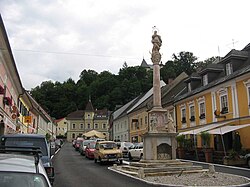Bleiburg
|
Bleiburg Pliberk |
||
|---|---|---|

Main square with plague column
|
||
|
||
| Location within Austria | ||
| Coordinates: 46°35′24″N 14°47′56″E / 46.59000°N 14.79889°ECoordinates: 46°35′24″N 14°47′56″E / 46.59000°N 14.79889°E | ||
| Country | Austria | |
| State | Carinthia | |
| District | Völkermarkt | |
| Government | ||
| • Mayor | Štefan Visocnik (SPÖ) | |
| Area | ||
| • Total | 69.72 km2 (26.92 sq mi) | |
| Elevation | 479 m (1,572 ft) | |
| Population (1 January 2016) | ||
| • Total | 4,030 | |
| • Density | 58/km2 (150/sq mi) | |
| Time zone | CET (UTC+1) | |
| • Summer (DST) | CEST (UTC+2) | |
| Postal code | 9150 | |
| Area code | 04235 | |
| Vehicle registration | VK | |
| Website | www.bleiburg.at | |
Bleiburg (Slovene: Pliberk) is a small town in the south Austrian state of Carinthia (Koroška), south-east of Klagenfurt, in the district of Völkermarkt, some four kilometres (2.5 miles) from the border with Slovenia.
The municipality consists of the twelve Katastralgemeinden Aich (Dob), Bleiburg, Grablach (Grablje), Kömmel (Komelj), Moos (Blato), Oberloibach (Libuče), Rinkenberg (Vogrče), Sankt Margarethen (Šmarjeta), Schattenberg (Senčni kraj), Unterloibach (Libuče), Weißenstein (Belšak) and Woroujach (Borovje). According to a 2001 census, 30.4% of the population are Carinthian Slovenes (in 1971, they were 52.8%).
The border town is located in the valley of the Feistritz creek, a right tributary of the Drava, north of the Peca massif of the Karavanke mountain range. It is home to a district court, military barracks and to the local productive and services industry. The name of Bleiburg, literally meaning 'Lead Castle', can be attributed to the lead mining operations in the Peca mountain.
The area was part of the Liupicdorf estate in the Duchy of Carinthia, which about 1000 Bishop Albuin I of Brixen dedicated to his brother Count Aribo. The oldest surviving document mentioning the town as castrum et forum Pliburch is dated to 1228. The comital estates of Bleiburg Castle were seized by the Habsburg dukes Albert III and Leopold III in 1369, the settlement received town privileges the next year. On 16 March 1393 Duke Albert granted the citizens the right to hold the annual Wiesenmarkt ('meadow market') fair, which has taken place every year up to today at least since 1428 on September 1. In 1601 the castle was ceded to the Thurn-Valsassina comital family, who had it rebuilt in its present Renaissance style and still owns it today, together with the nearby Hagenegg estate in Eisenkappel-Vellach.
...
Wikipedia


